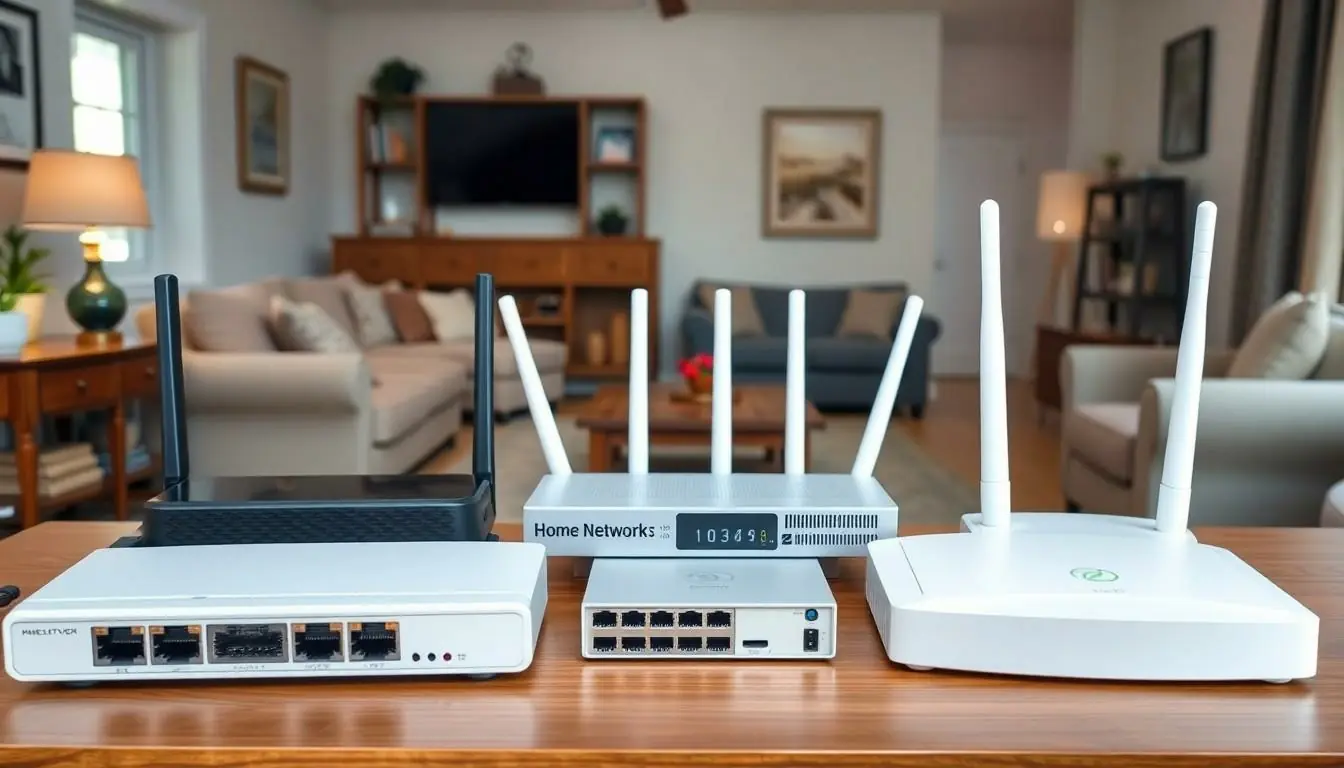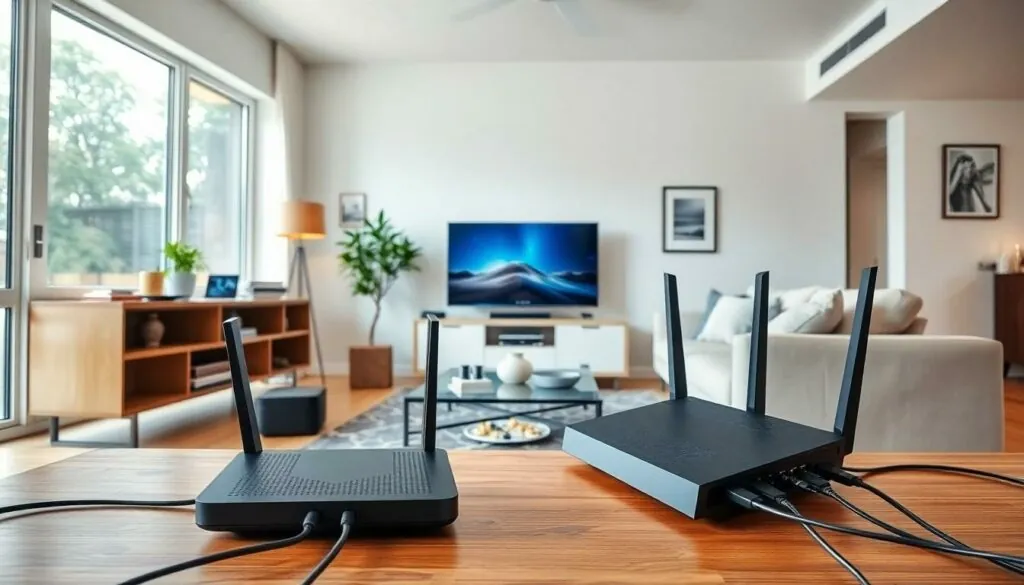Table of Contents
ToggleIn today’s tech-savvy world, a reliable home networking infrastructure is as essential as a good cup of coffee on a Monday morning. It’s the backbone of modern living, connecting everything from smart fridges to streaming devices, ensuring that every binge-worthy show and video call runs smoothly. But let’s face it: navigating the maze of routers, cables, and Wi-Fi signals can feel like trying to solve a Rubik’s Cube blindfolded.
Overview Of Home Networking Infrastructure
Home networking infrastructure serves as the backbone of modern technology use. This infrastructure typically includes routers, switches, and various cables that create a reliable communication system within a residence. Various devices like smart TVs, game consoles, and home security systems connect through this network, ensuring seamless functionality.
Routers distribute internet connectivity, while switches manage data traffic among connected devices. Fiber optic cables provide high-speed connections, particularly advantageous for streaming high-definition content and gaming. Wi-Fi signals allow for wireless connections, enabling flexibility in device placement throughout the home.
Security remains a critical aspect of home networking. Firewalls and encryption protocols protect sensitive information, preventing unauthorized access. Network management tools assist users in monitoring device connections and managing bandwidth effectively.
The complexity of managing wireless signals poses challenges for many homeowners. Interference from walls and electronic devices can disrupt connectivity, leading to frustrating experiences. Strategic placement of routers and the use of range extenders can enhance Wi-Fi coverage, improving overall performance.
In addition, smart home devices often rely on this infrastructure for functionality. Thermostats, lights, and cameras require stable internet connections to operate effectively. Ensuring a robust home networking system supports the increasing demands of connected devices in everyday life.
Ultimately, a well-configured home networking infrastructure enhances user experience by providing reliable access to the internet and internal resources. Understanding its components and management strategies empowers homeowners to optimize their home technology use.
Key Components Of Home Networking

Home networking infrastructure consists of several crucial components that work together to create a seamless connection among devices.
Routers
Routers act as the central hub of home networking. It distributes internet connectivity to various devices like computers, smartphones, and smart TVs. This connectivity enables streaming, gaming, and browsing simultaneously without significant interruptions. Additionally, modern routers often include built-in firewalls, enhancing security by monitoring and filtering incoming and outgoing traffic. Choosing a reliable router can directly impact overall internet speed and reliability.
Switches
Switches play a vital role in managing data traffic within a network. By connecting multiple devices through Ethernet cables, switches help ensure efficient data transfer. They reduce data packet collisions, which enhances speed for local traffic. A network switch allows devices like printers and gaming consoles to communicate effectively, providing a wired connection that often surpasses the performance of Wi-Fi. Utilizing switches is essential for optimizing performance in larger homes with numerous devices.
Access Points
Access points extend a network’s wireless coverage throughout a home. By connecting to a router, these devices enhance signal strength in areas where Wi-Fi may be weak. Installing access points can effectively eliminate dead zones, promoting a reliable connection in all rooms. They support numerous devices without significantly degrading performance. Investing in access points ensures every corner of a home benefits from strong and stable internet access.
Setting Up Your Home Networking Infrastructure
A well-structured home networking infrastructure ensures seamless connectivity. This process involves careful planning and the right selection of equipment.
Planning Your Network Layout
Mapping the network layout starts by identifying key areas where devices will operate. Positioning the router in a central location promotes improved signal distribution. Consider potential obstacles like walls that can weaken signals. Placing access points strategically helps cover dead zones and boosts performance. Prioritize high-demand areas, such as the living room or home office, for optimal connection. Incorporating a wired connection for stationary devices enhances speed and reliability. Analyze device types to determine necessary bandwidth and prioritize accordingly.
Choosing the Right Equipment
Selecting the right equipment significantly impacts network performance. Start with a router that meets current and future speed requirements, focusing on Wi-Fi standards like Wi-Fi 6 for faster connections. Switches are essential for homes with multiple wired devices, providing efficient data management. When dealing with extensive coverage, consider adding range extenders or mesh systems. Evaluate options for fiber optic or high-quality Ethernet cables to ensure fast and stable connections. Finally, invest in security features like firewalls to protect sensitive information.
Common Issues and Troubleshooting
Home networking infrastructure can face various challenges. Identifying and addressing issues quickly enhances user experience.
Connectivity Problems
Devices often encounter connectivity problems, disrupting internet access. Slow speeds and dropped connections frequently emerge from outdated routers or service outages. Users should check their modem and router, ensuring proper connections. Restarting the router can resolve common issues. For persistent problems, updating firmware is crucial. Devices like printers or smart TVs might require reconfiguration after changes. Checking the service provider’s status can clarify if outages affect connectivity.
Signal Interference
Signal interference affects both Wi-Fi speed and reliability. Walls, appliances, and even neighboring networks can disrupt signals. To mitigate interference, positioning the router in a central location is effective. Using 5 GHz bands helps reduce conflict with other devices, improving performance. Advanced options include employing range extenders or mesh systems to enhance signal coverage throughout the home. Identifying competing networks using apps can aid in selecting less congested channels.
Future Trends in Home Networking Infrastructure
Increased demand for seamless connectivity drives innovation in home networking infrastructure. Mesh networking systems become more popular as users seek robust Wi-Fi coverage in larger homes. These systems utilize multiple nodes that work together to enhance signal strength and eliminate dead zones. Enhanced bandwidth becomes crucial as smart homes adopt more devices that require continuous internet access.
Wi-Fi 6 technology improves efficiency and speed, optimally supporting multiple devices simultaneously. With increased data transfer rates, families can stream high-definition content, work remotely, and game online without interruptions. Security advancements also remain a strong focus amid growing cyber threats, with manufacturers implementing better encryption and firewall solutions to protect user data.
Moreover, integration of artificial intelligence simplifies network management. Smart routers automatically adjust settings based on usage patterns, optimizing performance for specific device types. Enhanced analytics tools allow homeowners to monitor their network health in real-time, offering insights into potential issues.
5G technology introduces unprecedented opportunities for home networking. This technology promises faster connectivity, providing alternatives to traditional broadband options. Users can experience lower latency, facilitating high-quality video conferencing and smoother online gaming.
Dynamic network protocols emerge, allowing devices to adaptively choose the best connection method between wired and wireless. This innovation further optimizes performance, improving overall user experience.
Evolving technologies like Wi-Fi 6, mesh networks, AI integration, and 5G shape the future of home networking infrastructure. Homeowners increasingly seek reliable systems that support their growing digital lifestyles.
A well-structured home networking infrastructure is vital for today’s connected lifestyle. It not only enhances the user experience but also supports the demands of multiple devices seamlessly. By understanding the components involved and implementing effective management strategies, homeowners can ensure reliable internet access throughout their spaces.
As technology evolves, staying informed about advancements like mesh networks and Wi-Fi 6 will be crucial. Investing in the right equipment and security measures will protect sensitive information and optimize network performance. Embracing these changes will empower homeowners to navigate the complexities of their digital environments confidently.



